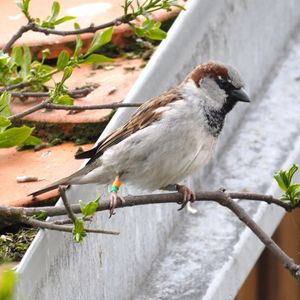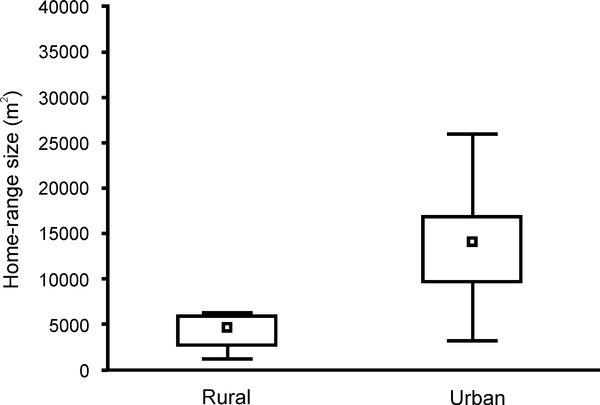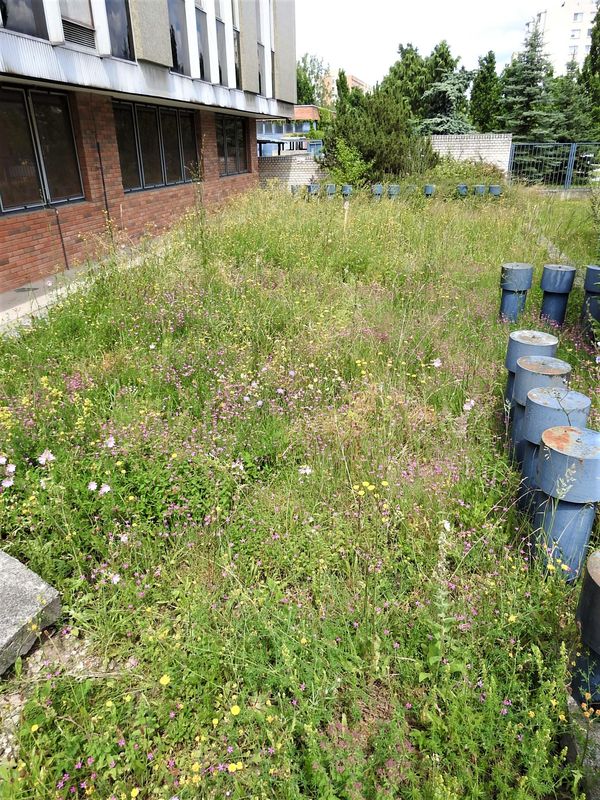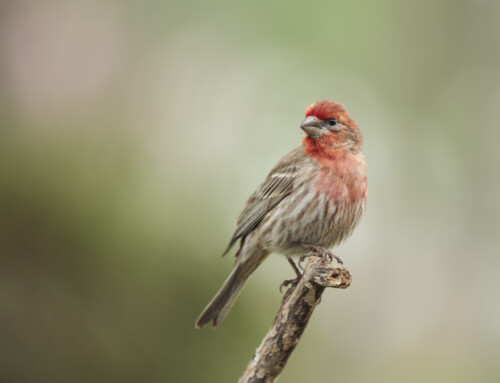 LINKED PAPER
LINKED PAPER
A comparison of foraging-range sizes, flight distances and foraging habitat preferences in urban and rural House Sparrow (Passer domesticus) populations. Havlíček, J., Riegert, J. & Fuchs, R. 2022 Ibis. doi: 10.1111/ibi.13072 VIEW
Bird populations that inhabit human settlements including villages, farms, and highly urbanised cities, are currently facing massive pressure due to increasing urbanisation, changes in farming, etc. (Bernat-Ponce et al. 2020; Rosin et al. 2021). Due to its close association with humans, their settlements, and surrounding habitats, the House Sparrow (Passer domesticus) has become an indicator bird species representing changes in these habitats. This species attracted enormous public and scientific interest after the significant population changes throughout most of its distribution, which began in the second half of the last century. Many studies, mostly carried out in western Europe, pointed out that reduced food availability was to blame for the House Sparrow’s population decline in farms and cities (Hole et al. 2002; Vincent 2005). Surprisingly, detailed studies of fine-scale habitat use by House Sparrows during the breeding period are lacking.
Our study used focal-individual observations to study habitat utilisation and foraging behaviour in typical Central-European urban and rural settlements. Direct observations of House Sparrows allows for the detailed mapping of available habitats throughout our study site.

Figure 1 An example of a typical House Sparrow foraging range within urban (a) and rural (b) environments and overlap with mapped habitats and feeding site positions. The solid line indicates Kernel density estimation (KDE 50% utilisation distribution), and the dashed line indicates (KDE 95% UD) foraging range. The shape of patches was simplified for the visualisation, with respect to their area.
We found that urban House Sparrow parents have approximately three times larger foraging-range sizes and fly ca. 1.4 times longer to collect food for their nestlings, than their rural conspecifics. Food from human sources, e.g., from bins and containers in urban areas and poultry farms in rural settlements, were preferred in both environments. We argue that mainly plant-based food from these “fast-food” sources, represented by food debris, pastry and cereal mix for poultry, have lower nutritional quality. We also found a preference for ruderal habitats, which were much less available within urban environments, and shrubs and trees which provide invertebrate prey.
Sparrows flew longer distances when visiting preferred habitats, e.g., poultry farms, bins/containers and tall ruderal areas. In the urban population, the flight distance to shrub and tree patches was twice as long as the rural site (Havlíček 2021). In contrast to our previous findings (Šálek et al. 2015, Havlíček et al. 2021), when feeding offspring, House Sparrows did not frequently use farm infrastructure, including cowsheds, manure heaps, silage pits and grain storage. Farms support birds by providing an abundance of invertebrate prey through the existence of a mosaic of habitats which includes short and tall ruderal vegetation.

Figure 2 Comparison of foraging range sizes of KDE 50% for House Sparrow pairs breeding in urban and rural environments. Square – median, box – 25-75% of data, whiskers – non-outlier range.
In conclusion, suitable habitats in the urban environment are scarce and scattered, and some are entirely missing. Thus, parents in urban areas have to invest more energy in collecting food for nestlings. Additionally, the most critical foraging habitats are under continued pressure from anthropogenic development and are at risk of changing to less suitable habitats throughout both environments (Bernat-Ponce et al. 2020, 2021, Šálek et al. 2018). The rapid and substantial changes in habitat composition in rural settlements and farms can be demonstrated by our study site. A few years after the fieldwork, we found that a significant part of the tall ruderal habitats and some rarely managed shrub patches were replaced by more intensively managed lawns and smaller shrubs. Similarly, at our urban study site, the reduction of shrub patches occurred and was replaced by intensively managed lawns.
How can we help House Sparrows and other birds in human settlements?
As indicated above, action to protect and support House Sparrows and other birds in human settlements has to be taken. Reducing the intensity of green space management, e.g., grass mowing, shaping of trees and shrubs, using herbicides and insecticides, in all types of settlements will help local populations. Additionally, establishing new shrub patches and wildflower strips with ruderal species can provide natural invertebrate and seed food sources. For example, in our urban study site, wildflower strips have been newly introduced. Improved suitable habitats should be spread and connected to make them sufficiently available for the small passerine species with small foraging ranges.

Figure 3 An example of a wildflower strip recently introduced to some places within our urban study site. It contrasts with the coverage of the rest of the “green space” in our urban study site, represented mainly by the intensively managed lawns and woody vegetation © Jiří Řehounek.
In rural settlements, House Sparrows can profit from the support of traditional small-scale farming, especially the keeping of poultry. On the other hand, the continuing intensification of agriculture can reduce food availability and breeding site opportunities (Šálek et al. 2018, Havlíček et al. 2021). Thus, the support of small traditional farms focused on mixed farming, including dairy, meat, and crop production, can play a crucial role. Additionally, we recommend establishing less-managed patches with the presence of native “ruderal” plant species within farms.
References
Bernat-Ponce, E., Ferrer, D., Gil-Delgado, J. A. & López-Iborra, G. M. 2021. Effect of replacing surface with underground rubbish containers on urban House Sparrows Passer domesticus. Urban Ecosystems 25: 121-132. VIEW
Bernat-Ponce, E., Gil-Delgado, J. A. & López-Iborra, G. M. 2020. Replacement of semi-natural cover with artificial substrates in urban parks causes a decline of house sparrows Passer domesticus in Mediterranean towns. Urban Ecosystems 23: 471-481. VIEW
Havlíček, J. 2021. The breeding and foraging ecology of the House Sparrow in rural and urban environments. Ph.D. Thesis Series, No. 16. University of South Bohemia, Faculty of Science, School of Doctoral Studies in Biological Sciences, České Budějovice, Czech Republic, 226 pp. VIEW
Havlíček, J., Riegert, J., Bandhauerová, J., Fuchs, R. & Šálek, M. 2021. Species-specific breeding habitat association of declining farmland birds within urban environments: conservation implications. Urban Ecosystems 24: 1259-12770 VIEW
Hole, D. G., Whittingham, M. J., Bradbury, R. B., Anderson, G. Q. A., Lee, P. L. M., Wilson, J. D. & Krebs J. R. 2002. Widespread local house-sparrow extinctions agricultural intensification is blamed for the plummeting populations of these birds. Nature 418: 931-932. VIEW
Rosin, Z. M., Pärt, T., Low, M., Kotowska, D., Tobolka, M., Szymański, P., & Hiron, M. 2021. Village modernisation may contribute more to farmland bird declines than agricultural intensification. Conservation Letters 14: e12843. VIEW
Šálek, M., Bažant, M. & Żmihorski, M. 2018. Active farmsteads are year‐round strongholds for farmland birds. Journal of Applied Ecology 55: 1908-1918 VIEW
Šálek, M., Havlíček, J., Riegert, J., Nešpor, M., Fuchs, R. & Kipson, M. 2015. Winter density and habitat preferences of three declining granivorous farmland birds: the importance of the keeping of poultry and dairy farms. Journal of Nature Conservation 24: 10-16. VIEW
Villaseñor, N. R., Chiang, L. A., Hernández, H. J. & Escobar, M. A. 2020. VVacant lands as refuges for native birds: an opportunity for biodiversity conservation in cities. Urban Foresty & Urban Greening 49: 126632. VIEW
Vincent, K. E. 2005. Investigating the causes of the decline of the urban house sparrow Passer domesticus population in Britain. De Montfort University, Leicester, Ph.D. thesis.
Image credit
Top right: Colour-ringed male of House Sparrow Passer domesticus © Jan Havlíček.
If you want to write about your research in #theBOUblog, then please see here.




